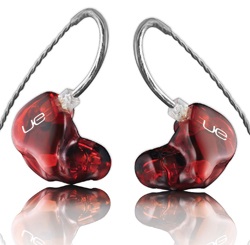Editor’s Note: This article originally appeared in October 2010, a time when in-ear monitoring had become a widespread practice in professional audio.
In the early 1990s we were the kings of grunge, based in Seattle. We were the capital of music at the time, and we had a ton of wedges. Literally, a ton or more, as our company had over 100 of them. A few hours down the road in Oregon, we heard tales of a well established rock band using custom-fitted “headphones” that went inside the ear, like a hearing aid.
At the time I remember saying, “that’s the dumbest thing I’ve ever heard – it will never fly.” Not too long after, our big rock band client had a drummer that used them, and by the next tour the rest of the band had adopted them. In-ear monitors (IEMs) were here to stay and I loved them. By the end of the decade, many if not most of our clients had switched.
IEMs are one of the turning points in modern sound reinforcement, right up there with line arrays, digital consoles, satellite television on the bus, and carrying your own catering on tour. They are an effective tool to control the age-old demon of stage volume.
But like any other good solution, there are trade-offs. The artist may feel isolated. There might not be the experience or expertise to provide an adequate mix. But using IEMs is not too difficult, and even with basic tools used properly, one can get excellent results.
Here are some simple ways to get the most out of IEM applications that you’ll be able to use if you’re a weekend club warrior, mixing the worship band, or out on the touring circuit.
Creating An Environment
First, we want to make sure we don’t do anything rash. With any monitor gig, trust is key, so you don’t want to blow it with your artist by appearing to be haphazard.

Just as with mixing for loudspeakers, gain structure is a key. Gain structure irregularities, as well as hums and buzzes, become extra obvious in an IEM mix, so make sure your rig is as clean as possible in terms of noise.
Custom-molded IEM earpieces offer about 30 dB of attenuation to the outside, while generic earpieces offer less, depending on the method of sealing. Regardless, they change the monitor mix game to being less about sheer volume or dealing with outside issues — for example, stage volume or the volume of the house system — to creating an environment that makes the artist comfortable.
The isolation may lead the monitor engineer to add inputs into the mix that are not in a traditional wedge mix. But the amount and exact nature of these inputs will depend on the preferences of the artist. For example, an input not used in wedge mixes is ambient microphones, but these can be a welcome addition for IEM applications.
My preference is to use small profile shotguns and fade the input from these mics in and out of the mix only as necessary, usually just between songs to allow the artist to hear and experience the audience reaction. Others, however, use ambience as part of their mix, but in my opinion, this can “smear” it, making it seem less direct and more distant.
Whenever possible, I place the shotgun mics downstage, away from the house loudspeakers, and try to get as much audience and as little stage or main system volume as possible. The goal is to get IEM earpieces that sound great on their own, much like with reference monitors. Some earpieces are best with specific music types, just as with some loudspeaker systems.
Recently there has been a trend in both loudspeaker and earpiece design that take an approach of having the best response possible, as opposed to “coloring” the sound so that it sounds better in some applications than others.
Dynamic Flavor
In many ways, building an IEM mix is like building any other mix, with my approach leaning toward “less is more.” I always configure it as a stereo mix, and don’t typically use any equalization on the mix output buses, but there are times when I will run some sort of compression or limiting on the mix buses.
In the past, this was more for protection, but these days, depending on the artist, it is possible to use methods similar to studio mastering techniques to enhance the quality of the finished mix. Proceed with caution though if you’re new to this approach, because it’s easy to squash the life out of the mix through overuse, robbing it of any dynamic flavor.
To counter the isolation factor, I strive to create an environment by crafting a mix with depth and space, largely by using panning, level and reverb. Being isolated reduces the localization of the instruments on stage and can create a dry feeling.
It really depends on the preferences of the artist. I’ve had instances where it was more like a traditional mix, particularly for vocalists — though with the vocal more pronounced. Other times, it was just that player’s instrument with click and very little melody and rhythm instruments.
I’ve also built mixes where the artist preferred non-standard panning arrangements, such as all backing vocals extreme-panned to one side and the primary vocals to the other side, or the classic Beatles panning of all instruments on one side and all vocals on the other. Working with your artists is the only way to insure you get what it is they wish.
In building the musical bed of the mix, I again go with the “less is more” mantra, sticking with the basics. The techniques include mic selection, placement, and working at the source to get the best result possible before it’s introduced into the equipment.
Some mix engineers have specific mics they use in all instances on particular instruments. My approach is to listen to each individual instrument or vocal, and then select the input devices I think will best represent each of these sources.
Of course, this isn’t always possible, and in many cases, is easier said than done. Some artists may have favorite mics, or you might not be in a position to carry your own mics and instead must rely on a limited selection from the provider. As a result, it’s best to know how a wide variety of mics work and then what may be best in your specific application.
Being able to dictate what you use is the best-case scenario, I’ve heard many mixes that were compromised by the mix engineer applying a one-size-fits-all philosophy to dynamics processing, so you need to be flexible enough to deliver the desired results when equipment choices are limited.
Stare Of Doom
When working with the individual inputs that comprise the mix, again, I try to keep equalization to a minimum, and strive to use none. This isn’t possible in many cases, particularly if I can’t dictate the mics or control the source. At this point, it’s about listening and making only necessary changes. Rather than just “fishing” for the EQ points, it’s better to know where in the spectrum needs to be adjusted.
A big pet peeve of mine is when a mixer isn’t ear trained and needs to bump the frequencies to see if they made the right guess. That’s annoying enough through loudspeakers, but if the artist is using IEMs, you’ll likely get the stare of doom.
I tend to apply more processing — particularly reverb and multi effects — when mixing IEM than in a traditional wedge environment. It’s not uncommon to have a half-dozen effects units and a dozen or more dynamics processors.
However, while I may use more devices, they are used sparingly, only enough to get the desired results. I’ve heard many mixes that were compromised by the mix engineer applying a one-size-fits-all philosophy to dynamics processing.
Simply, it’s better not to use these tools rather than letting them detract from the mix. Be especially aware when using compression on vocalists — too much and they might compromise mic technique and vocal style to compensate for the effects of the compression.
By sticking to the basics and properly using the gear you have, it’s not rocket science to craft quality IEM mixes. Using common sense, being methodical and organized, and knowing the equipment helps in better dealing with any situation.
Finally, command of the craft instills the artist with a sense of confidence. This, in and of itself, will keep you working for many years to come.















